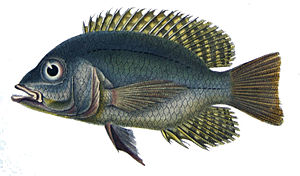Chaetobranchus
| Chaetobranchus | ||||||||||||
|---|---|---|---|---|---|---|---|---|---|---|---|---|

Chaetobranchus flavescens , drawing from Castelnau's Expédition dans les parties centrales de l'Amérique du Sud, de Rio de Janeiro à Lima, et de Lima au Para: exécutée par ordre du gouvernement Français pendant les années 1843 à 1847. - Paris: P. Bertrand , 1850-1857 |
||||||||||||
| Systematics | ||||||||||||
|
||||||||||||
| Scientific name | ||||||||||||
| Chaetobranchus | ||||||||||||
| Heckel , 1840 |
Chaetobranchus is a genus of cichlids from tropical South America . The scientific genus name refers to the fine, long gill traps of the genus ( Gr .: "Chaetos" = bristle + "branchiae" = gill). The two species of the genus occur in the Amazon basin , in the Orinoco river basin and in the three guayanas in slowly flowing waters.
features
Chaetobranchus species grow to be 21 to 25 centimeters long. Your body is high, flattened on the sides, the head profile is pointed. Their basic color is yellowish to brownish. The fish have a silvery metallic shimmer. They differ from all other South American cichlids by adapting to a plankton-eating way of life. Their gill-trap rays on the first gill arch are long, slender and close together. In the direction of the skull and the hypobranchial they gradually get shorter and the distance increases. The Chaetobranchus species are the only cichlids with toothed basibranchials, the lowest sections of the gill arches. Another characteristic unique to Chaetobranchus is the possession of tiny gill-trap rays in the lower pharynx.
The mouth is large, the narrow rows of teeth sitting on the jaws are small with a single point. The lower pharynx is long and slender, with a deeply incised rear edge, and studded with numerous small, pointed teeth. The lips are continuous, the lower lip protrudes at the corner of the mouth over the rear edge of the upper lip. This lip type ("American-type") is characteristic of New World cichlids (subfamily Cichlinae ). The scaling in front of the dorsal fin is irregular. On the underside, on the throat, there is a group of scales that are separated from the rest of the scales. The lateral line system includes seven pores on the gill cover and five on the lower jaw, as well as further head pores. Unusual for cichlids are some rows of pore-bearing scales on the caudal fin, one long between the fin rays D1 and D2 and another on the lower part of the caudal fin, which is an extension of the lower lateral line.
Systematics
Together with the sister genus Chaetobranchopsis , Chaetobranchus forms the tribe Chaetobranchini within the New World cichlids ( Cichlinae ), which forms the sister group to the Geophagini . Of Chaetobranchopsis differs chaetobranchus spines inter alia, by 5 to 6 (4 in most cases) in the anal fin, Chaetobranchopsis has three spines.
species
- Chaetobranchus flavescens Heckel, 1840 type species ; Widespread in the Amazon and Orinoco basins and in the three guayanas, dorsal and anal fin scaly, 16 scales in a transverse row, no eye spot on the caudal fin base, no vertical stripes on the sides of the body.
- Chaetobranchus semifasciatus Steindachner, 1875; only in the central Amazon region between Óbidos and Tefé , dorsal and anal fin scaly, 20 smaller scales in a transverse row, an eye spot on the caudal fin base, broad, vertical stripes on the sides of the body. Compared to Chaetobranchus flavescens , this species has a slightly protruding lower jaw and narrow rows of scales on the bases of the dorsal and anal fins. Kullander has therefore considered transferring it to a further monotypical genre, but has not (yet) taken this step. .
literature
- Günther Sterba : The world's freshwater fish. 2nd Edition. Urania, Leipzig / Jena / Berlin 1990, ISBN 3-332-00109-4 .
- Claus Schaefer: Chaetobranchus. In: Claus Schaefer, Torsten Schröer (Hrsg.): The large lexicon of aquaristics. Eugen Ulmer, Stuttgart 2004, ISBN 3-8001-7497-9 , p. 204 f.
Individual evidence
- ↑ Hernán López-Fernándeza, Kirk O. Winemillerc, & Rodney L. Honeycutt: Multilocus phylogeny and rapid radiations in Neotropical cichlid fishes (Perciformes: Cichlidae: Cichlinae). Molecular Phylogenetics and Evolution Volume 55, Issue 3, June 2010, Pages 1070-1086 doi : 10.1016 / j.ympev.2010.02.020
- ^ Kullander, SO (1984): Review of the South American Cichlidae . Stockholm
Web links
- Website of the Swedish cichlid specialist Sven O. Kullander: Chaetobranchus Heckel
- Chaetobranchus on Fishbase.org (English)